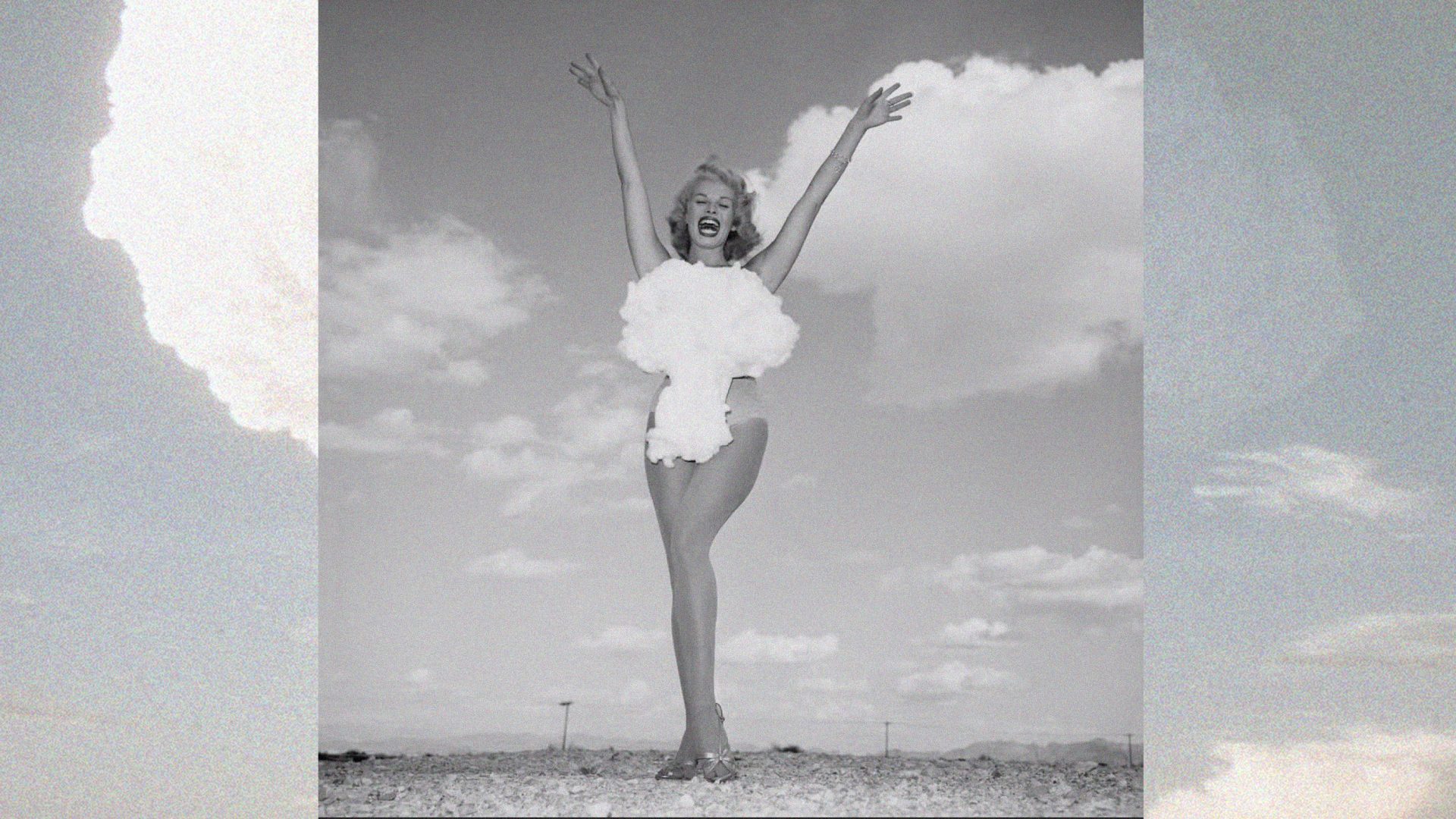There’s a remarkable image on display at “Splash! A Century of Swimming and Style”, a new exhibition at the Design Museum in London. It features a showgirl named Linda Lawson reclining by the pool at the Sand’s Hotel in Las Vegas beaming at the camera. She has a large cotton wool mushroom cloud attached to her head and has just been crowned Miss Cue, in honour of the upcoming Nevada atomic bomb test.
It’s a relic from the time when the atom bomb was considered a symbol of modernity and progress. The device had recently brought the second world war to an end and the nuclear technology on which it was based now promised a cheap and effective source of energy. Many people headed to Nevada test sites to witness the awesome power of the A-Bomb. The atomic age was born and it would deeply influence culture, design and fashion.
“You’ve got this moment where atomic power feels quite like a positive,” Amber Butchart, curator of the Splash exhibition, told me, “It’s this thing that the good guys have. Obviously, that then changes as the Cold War develops.”
America had revealed the destructive threat of the bomb in 1945, with the destruction of Nagasaki and Hiroshima. But news that the Soviet Union was also developing a nuclear weapon made the US determined to maintain its nuclear pre-eminence. On July 1, 1946, a nuclear device nicknamed “Gilda” after the recent Rita Hayworth movie, detonated in a remote coral reef in the Marshall Islands called the Bikini Atoll. A few days later, a companion bomb, Helen of Bikini, was detonated in the same area.
As a temporary precaution the local inhabitants had been evacuated, assured that the experiments taking place were of vital historical importance. But the evacuation was not temporary. The Bikini atoll is still uninhabited. These nuclear devices, and other even more powerful bombs subsequently tested there, created far higher levels of radioactive residue than was estimated, the devices detonated underwater sending up vast columns of radioactive sea spray.
In private, the tests were considered a failure. Russian observers, invited to watch America’s mighty new capability, were apparently unimpressed by what they saw. The first bomb, on July 1, was dropped around 600m off target and missed its aim point by such a wide margin that many of the ships anchored in the lagoon went unsunk. But this was not how it was reported. Headlines around the world marvelled at the might of the bomb and the possibilities it held. And, as Linda Lawson showed, it would have an enduring effect on one surprising area in particular: swimwear.
One man who took particular interest in the news coming from the Marshall Island was a former civil engineer called Louis Réard. He had inherited his mother’s Paris-based lingerie business just as the Second World War had begun and by the end of hostilities, he was looking for a way to reinvigorate his business.
Another Frenchman, Jacques Heim, was a distinguished fashion designer who started out in the family fur firm. He’d moved into haute couture during the 1930s and had established a well-regarded fashion house that bore his name. As he was Jewish, he was forced into hiding and became active with the French Resistance.
In the 1930s, Heim had dabbled with swimwear, creating a ruffled, two-piece garment that he dubbed the Atome, which was a reference to its atomically small size rather than the power of nuclear weapons (they had yet to be invented). But Heim was ahead of his time – very few people would ever dare to wear such a scandalously skimpy outfit. By after the war, and with atoms suddenly on everyone’s lips, he was ready to try and rebuild his business.
In June 1946, Heim re-released the Atome at his swimwear outlet in Cannes. To publicise the event, he flew a plane over the beaches of the Côte d’Azur, trailing a banner with the thrilling announcement: “The Smallest Swimsuit in the World”.
Louis Réard also had a new fashion innovation. He’d devised his own item of swimwear, a two-piece, but a two-piece with a difference. For the first time – scandalously – the wearer’s navel was revealed.
“Even in periods such as the 1920s when hemlines rose, the navel itself was still not bared,” Amber Butchart says. “So, it almost becomes symbolic of nudity itself.”
Réard’s creation consisted of just four triangles of material with a total size of 193 square centimetres. To reinforce the newsworthy nature of his design, the swimsuit’s material had a newsprint motif. Emblazoned on the fabric, alongside other newsworthy words, was the name: “Bikini”.
Just a few days after Heim’s launch, Réard’s new bikini swimsuit was unveiled in Paris at the popular Piscine Molitor swimming pool where a beauty pageant was taking place. After the contestants paraded in their more modest swimwear and a winner was crowned (winning the Réard Cup), a 19-year-old dancer from the Casino de Paris named Micheline Bernardini was sent out in Réard’s creation. Bernadini carried a box, the size of a match box, claiming the bikini would easily fit inside. It was a sensation.
Réard’s bikini knocked its nuclear namesake off the front pages. It’s claimed that the International Herald Tribune alone reported nine stories about Mademoiselle Bernardini and her scandalous, navel-revealing outfit. A version of this original bikini can be currently seen at the Splash exhibition alongside other iconic swimwear including Tom Daley’s Speedos and Pamela Anderson’s Baywatch one-piece.
“The one that we’ve got on display is still very, very small and wouldn’t have been worn by huge amounts of women,” Butchart says. “But it definitely had an influence on the future of swimwear.”
Réard, hearing of Heim’s innovations, headed south with the intention of launching his bikini on the rich and influential Côte d’Azur beachgoers. Like his rival, he engineered his own aerial advertising. His cheeky banner read: “Smaller than the smallest swimsuit in the world.” With that, the bikini wars had begun.
Réard patented his creation and became quite litigious if he felt anyone had copied his design or was using the name “Bikini” without consent. He enjoyed sparring with the press, releasing inflammatory statements such as his claim that a true bikini could easily fit through a wedding ring. He also released a new newsprint edition of the swimsuit every year.
But despite all this press, customers favoured Heim’s more modest designs, rather than Réard’s more revealing offering. Worse, the Catholic Church frowned upon all this bellybutton brandishing, which led to the bikini being banned in Italy, Spain and Portugal. The shock was not confined to Europe: the American Sears catalogue once airbrushed out the navel of a model who wore a two-piece suit.
“It caught on at different times in different places,” Butchart says. “It took a lot longer in America where there’s more prudishness. It was kind of staggered in terms of how quickly it became acceptable.”
It wasn’t until 1952 that Brigitte Bardot helped to popularise the garment, starring in Manina, the Girl in the Bikini. Underage at the time, Bardot’s father sued the production who had promised him they would not exploit his daughter’s body for profit. He lost the case.
As the fifties drifted into the more permissive sixties, the bikini became de rigueur. Despite Réard’s design initially being less popular with beachgoers, and despite its nuclear origins, the bikini name stuck. Réard went on to run his own Paris swimwear shop for the next 40 years. Heim, perhaps stung by the bikini wars, moved away from swimwear and headed further upmarket, clothing the likes of Sophia Loren and Madame Charles De Gaulle.
“What I find really interesting about this rivalry,” Butchart told me, “is how something so huge and destructive and geopolitical can have this outlet in swimwear. Swimwear designed by men of course, for women.”
And while the bikini grew more ubiquitous, its connection to nuclear testing faded from public consciousness, just as the early optimism of the atomic age was morphing into fear. A few weeks after the bikini’s launch, John Hersey’s Hiroshima was printed in the New Yorker, a book-long essay describing the devastation of that city, and that put a human face on the horrors of a nuclear attack.
The Cold War was a time of simmering threat and paranoia. The campy B-movies featuring atomically mutated giant ants or crabs, turned into the dread of films such as Fail Safe and Dr Strangelove.
That sense of nuclear threat has never gone away. Bathing beauties wearing mushroom clouds are inconceivable now, with figures such as Putin and Trump in power. But the bikini, this bizarre remnant of the atomic age, still reigns supreme. It’s perhaps one of the few reminders of a time when the energy of the atom was considered miraculous and optimistic. But you still aren’t allowed to swim in the waters around the Bikini Atoll. It’s still too dangerous.











